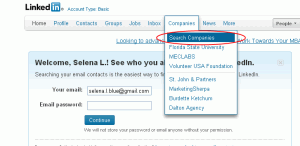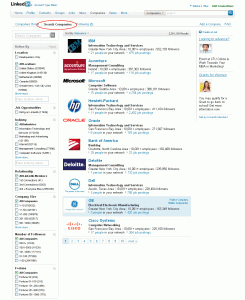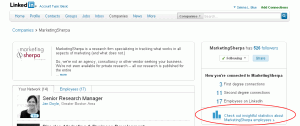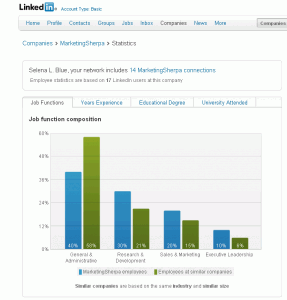Marketing Career: 7 habits of highly effective marketing job seekers – part 3
This third installation of the 7 Habits of Highly Effective Marketing Job Seekers blog post series will examine how Steven R. Covey’s fourth and fifth habits can help those looking for marketing positions (you can check out our discussions of “Be Proactive” and then “Begin with the End in Mind” and “Put First Things First” here).
“Think Win/Win” will help you decide which companies to apply to and what message to convey in your cover letters and interviews. The fifth habit, “Seek First to Understand, Then to be Understood,” will also help job seekers in crafting their cover letter message and resumes, but also provides tips on preparing for interviews.
Habit 4: Think Win/Win
In a Win/Win solution, all parties should mutually benefit and feel good about the decision. Covey says, for any type of situation, if both parties cannot reach a Win/Win, then they should agree on ‘No Deal’ or walk away from the table.
- A Win for the company
When I started thinking about how this habit relates to the job search, it reminded me a bit of President John F. Kennedy’s famous quote, “Ask not what your country can do for you, ask what you can do for your country.”
Instead of your country, though, ask what you can do for the company or organization to which you wish to apply. Then, relay that answer as your value proposition in both your cover letter and interview.
Some companies receive thousands of résumés for just one opening. Chances are you will not be the only applicant to meet all their minimum requirements. You must provide some added value that could push the company forward in some way.
What is your “wow factor”? Determining how the company will win with you as an employee will answer a vital question for any job seeker, “Why should my ideal employer interview me instead of other applicants?”
Inform employers exactly what you’ll bring to the table that no other candidate can.
- A Win for you
But don’t forget the second win. After all, it’s not all about the company. A job offer should result in a Win/Win for both the employee and the employer, so make sure the company fits you as well. Scott Howard, Executive Director of Operations, MECLABS, says one way to do this is to determine if the company culture meshes well with your personality.
You discover this by doing research not only on the job but on the company, too. Do you agree with their mission statement and values? Does it look like the company can provide room to grow your skills and career?
The Web lets you easily complete a little investigative work on a company. Alison Doyle lists a few websites that can help you determine the right companies for your target list. I’ll describe how two of them – LinkedIn and GlassDoor.com – can assist you in determining if a Win is possible for you.
LinkedIn is more than a place for companies to learn about you. It also serves as a great tool for job seekers to find company information.
LinkedIn provides a handy tool to search companies with profiles on the site. Once logged on, you can click on the “Companies” button on the top navigation. Then click “Search Companies” from the drop down window, as pictured below.
The “Companies Home” page will then appear. Simply click the “Search Companies” tab to begin your search. As you can see, Linked gives you many ways to search, from Fortune 500 companies to those “Hiring on LinkedIn.”
Once you find a company to research further, you look at their LinkedIn profile to find quite a bit of information. A great place to begin is the insightful statistics about the company. You can find a link to this page on the company’s main profile page:
The Statistics page shows you quite a few charts, full with useful job seeker information. The first chart displays Job Functions, Years Experience, Educational Degree and University Attended. All of these give you insight into the background of the company’s employees.
But going even farther down the page, you can answer some key questions for yourself.
Do you want to work for an expanding company? Then check out the statistics section of the company’s LinkedIn profile. The “Annual Company Growth” chart there shows the company’s number of new hires in comparison to similar companies within the same industry and similar size.
If you want a company that offers internal career growth, then the “New Titles” Tab below the “Annual Company Growth” chart shows the number of job title changes, including the old and new titles. The “Departures” tab gives insight into whether there might be a large turnover rate. A company’s LinkedIn profile page allows you to see if you have any existing connections to the company.
GlassDoor.com provides company review ratings, salaries, interview questions, jobs and more. On this site, larger companies tend to have the most listed information. But it’s worth giving a gander, because reading the reviews from current and past employees could let you see the company from a different viewpoint than other sources you’ll find while researching.
Key Takeaways:
- Create a value proposition around the added value you can offer the company to make them Win
- Write your cover letter to answer, “Why should my ideal employer interview me instead of other applicants?”
- Research companies to ensure they will provide you a Win – personally and professionally
Habit 5: Seek First to Understand, Then to be Understood
You should listen to understand, not just to reply. Empathetic listening helps you understand another person’s paradigm. It also creates an atmosphere of caring, respect and positive problem solving. The key result for job seekers to focus is on the positive problem solving. Focusing on positions that offer a Win/Win will lead to this result.
You should first start seeking to understand before you even arrive at an interview.
Read a job description in its entirety. Familiarize yourself with their keywords, responsibilities and requirements. Also, research the company on its website to know what things the company values that are not mentioned in the job description. Then, customize your cover letter in response to it.
Another way to make your cover letter stand out is to pose a solution to a problem the company has. This route would require some in-depth research. A case study or article might be able to help you. While I would not point fingers with their problem, I would highlight the skill required to solve the issue.
And as tempting as it is, resumes, too, are not one size fits all. Even positions with the same title differ in responsibilities, requirements and keywords from company to company.
In her MoneyWatch article, “How to work with a recruiter on LinkedIn,” Suzanne Lucas gives advice on how to write your resume so it gains the attention of HR software:
When you’re tweaking your resume to fit the job description, match the keywords from the job posting to ones in your resume. If the job posting says, “conjoint analysis,” and you can do that, but your resume says, “complex advanced statistical models,” you might not get noticed. Rather, write something like, “advanced statistical models including conjoint analysis, logistic regression, blah, blah, blah.” If you have the skill on the job posting, make sure the computer can figure that out. Those computers are very literal.
Once your customized cover letter and resume have earned you an interview, you must move into the next stage of understanding.
The research you did for the cover letter and resume will also prepare you for the interview you snagged. Look at the marketing efforts in the channels the position focuses on. If the position is email marketing, then subscribe to any newsletters or mailing lists. If you notice ways you would improve any sends you receive, then make notes of them. Bring those notes and suggestions to the interview and wait for an opportunity to bring them up.
For the interview, Eve Tahmincioglu says, “the employer talks 20- 50% of time and you should talk 50-80% of time,” according to the msnbc.com article, “In job interview, passion packs a punch.” Every interview will be different, so you must first understand what the employer wants before giving long-winded answers versus brief snippets. Knowing how much you should speak will come from taking direction from both the words and body language of the interviewer.
Also, listen to each question carefully before responding. Don’t think about your answer until you hear the whole question, or else you could miss an important aspect tagged onto the end.
For example, “What event marketing experience do you have?” could require a completely different answer than “What event marketing experience do you have with trade shows?”
Additionally, Scott says often you need to look beyond the overt question and know what the interviewer is really asking. These could include those crazy questions that don’t seem to relate to anything, let alone the job. You know, questions like, “What would you do if you inherited an elephant?” Another great example here is behavioral questions. Scott says for this type of question, you should “come prepared with examples.”
He says that the large majority of job seekers do not give good behavioral examples in their answers. Research common questions and prepare some examples to respond to relating to the position for which you are interviewing.
Scott asks one particular question in every interview he performs, no matter the position: “How do you handle conflict?” While the question doesn’t explicitly ask for examples, that’s really what he wants. Answering that you handle conflict well does not tell the interviewer much. Expound answers with specific examples. If the job is team oriented, then give an example revolving around conflict within a team. If the position you want regularly deals with vendors, provide an example about a situation you overcame while working with a vendor.
And remember, the job should be a Win/Win, so the employer should give you plenty of information to make the decision whether you want to continue in the hiring process with them. If not, ask for time at the end of the interview to ask questions and clarify concerns.
Key Takeaways:
- After fully understanding the position, match the keywords from the job posting to ones in your resume
- Use active and emphatic listening throughout the interview to fully understand questions
- Look beyond the overt question and know what the interviewer is really asking
- Use specific examples to back up your answers to interview questions
Related Resources:
Marketing Career: 3 steps to optimize your LinkedIn profile
Marketing Career: How to get your next job in marketing
Marketing Career: Can you explain your job to a six-year-old?
Categories: Marketing Careers cover letter, keywords, LinkedIn, marketing career, resume, value














This blog series, 7 Habits of Highly Effective Marketing Job Seeker, has been some of the best succinct information on effective job seeking. You have done a great job in your research, using a prior behavioral foundation to base job seeking behavior, and the writing has been compelling. I am looking forward to the rest of the series.